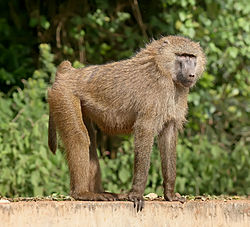Old World monkey
family of mammals From Wikipedia, the free encyclopedia
Remove ads
The Old World monkeys or Cercopithecidae are a group of primates which are native to Africa and Asia today.
The Old World monkeys inhabit diverse environments from tropical rain forest to savanna, shrubland, and mountainous terrain. They are also present in the fossil record from Europe, with a (possibly introduced) free-roaming group still surviving in Gibraltar (Europe) to this day.[3] Old World monkeys include many of the most familiar species of nonhuman primates, such as baboons and macaques.
Old World monkeys are medium to large in size, ranging from arboreal forms, such as the Colobus, to fully terrestrial forms, such as the baboons. The smallest is the talapoin, with a head and body 34–37 cm in length, and weighing between 0.7 and 1.3 kilograms, while the largest is the male mandrill at around 70 cm in length, and weighing up to 50 kilograms (females are considerably smaller).[4]
By appearance, Old World monkeys are distinguished from apes in that most have tails (the family name means "tailed ape"), and from New World monkeys in that their tails are never prehensile (used for holding on).
In most species, daughters remain with their mothers for life, forming a basic social group among Old World monkeys known as a matrilineal troop (led by the dominant female). Males leave the group upon reaching adolescence and find a new troop to join. In many species, only a single adult male lives with each group, driving off all rivals, but others are more tolerant, establishing relationships between dominant and subordinate males. Group sizes are highly variable, even within species, depending on the availability of food and other resources.[4]
Remove ads
Related pages
References
Other websites
Wikiwand - on
Seamless Wikipedia browsing. On steroids.
Remove ads


